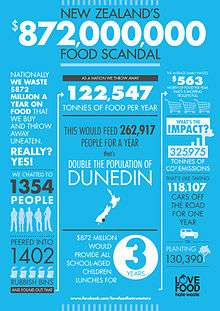Food waste in New Zealand
Food waste in New Zealand is one of the many environmental issues that is being addressed by industry, individuals and government.
The total volume of food wasted in New Zealand is not known as no research to date (2016) has been undertaken to determine commercial or supply chain food waste. However research has been undertaken into household food waste.
Household food waste
A Waste Not Consulting report to the Ministry for the Environment “Household Waste Data 2008”, calculated that, in 2008, 1,048,993 tonnes of waste were generated by the residential sector, an average of 260 kg per person or 676 kg per household per annum. Over 44% of this household waste was organic, with 24.7% (or 258,886 tonnes) of the total being kitchen waste, and 19.6% being greenwaste (205,526 tonnes).[1]
More detailed research into food waste generated by households, that was disposed of through curbside rubbish collections, was conducted by Waste Not Consulting in 2014 on behalf of WasteMINZ.[2][3] The rubbish bins of 1,402 households were studied with their food waste sorted, weighed and costed. The study found that 229,022 tonnes of food is sent to landfill by households annually. Of this approximately 50% or 122,547 tonnes is avoidable food waste. The national cost of avoidable household food waste disposed of to landfill in 2014/2015 was $872 million pa. Eliminating this food waste would have the same effect as reducing CO2 equivalent emissions by 325,975 tonnes – equivalent to planting 130,390 trees or taking 118,107 cars off the road for a year.

The average New Zealand household wastes $563 worth of food pa approximately 79 kilos.

The top ten foods wasted in 2015 were:
- Bread 10%
- Left overs 8%
- Potatoes 5%
- Apples 3%
- Poultry 3%
- Bananas 3%
- Lettuces 3%
- Oranges 2%
- Pumpkin 2%
- Carrots 2%.
Statistics on exactly how much edible food is wasted by households and composted, fed to animals or disposed of through a kitchen waste disposal unit is not known. A 2014 survey of 1,365 households found that 66% of those surveyed disposed of some of their food through the council kerbside collection, with 47% disposing of some of their food through composting, 35% through feeding animals and 28% through a kitchen disposal unit.[4] The Love Food Hate Waste Campaign launched in New Zealand on 1st June 2016. The campaign supports families to waste less food by encouraging behaviours to reduce food waste such as using leftovers and correct storage of food.
Commercial food waste
Some commercial food waste is used to supply pig farms although pig safety concerns and the need for sorting and unpacking makes it less viable. The Biosecurity (Meat and Food Waste for Pigs) Regulations 2005, passed under the Biosecurity Act 1993, prohibits feeding pigs with uncooked meat or food that has been in contact with uncooked meat.[5] This is done in order to prevent the spread of diseases to pigs.
In Auckland Ecostock Supplies[6] collects & recycles food waste from manufacturers, retailers, importers and transport companies to make high-quality stock feed.
In Wellington the Kai to Compost scheme[7] addresses commercial food waste in the city. It was initially a trial scheme with government funding but is now a user pays scheme involving 50 businesses.[8]
Supermarkets do not sell foods that are past their use by date for legal reasons and perceived danger to health.[9] Many supermarkets have partnered with food banks around the country and now donate tinned and packaged food which has passed its best before date, but it still safe to eat. A number of food rescue groups have also been set up in larger urban centres such as KiwiHarvest[10] in Auckland, Kaibosh[11] in Wellington, Kaivolution[12] in Hamilton , Foodshare[13] in Dunedin to rescue fresh food and produce. This is then distributed to local food banks and social agencies.
Dumpster diving, especially at supermarkets, is done to gather discarded food. The Christchurch branch of Food not Bombs use discarded food to feed people at film nights and markets.[14]
Food waste from ships and aircraft is incinerated as a requirement of the Biosecurity Act 1993 to prevent unwanted pests and diseases from entering New Zealand.
See also
References
- ↑ http://www.wasteminz.org.nz/pubs/2013-report-on-food-waste-in-new-zealand/
- ↑ WasteMINZ
- ↑ http://www.wasteminz.org.nz/pubs/new-zealand-food-waste-audits-2014-2015/
- ↑ http://www.wasteminz.org.nz/pubs/national-food-waste-prevention-study-into-attidutes-towards-food-waste/
- ↑ "Biosecurity (Meat and Food Waste for Pigs) Regulations 2005 (SR 2005/150)". New Zealand Government. 2005. Retrieved 2009-08-16.
- ↑ Ecostock Supplies
- ↑ Kai to Compost scheme
- ↑ Environment New Zealand 2007. Wellington: Ministry for the Environment. December 2007. ISBN 978-0-478-30191-5. Retrieved 2009-08-16.
- ↑ Broach, Mark (2009-08-09). "Welcome to the waste land". Sunday Star Times. Retrieved 2009-08-16.
- ↑ KiwiHarvest
- ↑ Kaibosh
- ↑ Kaivolution
- ↑ Foodshare
- ↑ Knight, Kim (2006-06-18). "Let's skip dinner". Sunday Star Times.
Further reading
- Stuart, Tristram (2009). Waste: Uncovering the global food scandal. Penguin. ISBN 978-0-14-103634-2.
External links
- New Zealand's Love Food Hate Waste Campaign
- Biosecurity New Zealand - Feeding Food Waste to Pigs